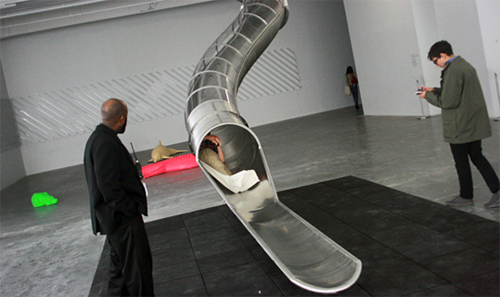"It is not the task of a museum to stimulate the economy; there are generally much better means of achieving that goal. A theme park, for example, may be better able to stimulate the economy." This line, from a chapter on "The Economics of Museums" in the "Handbook of the Economics of Art and Culture," flashed into my head yesterday when I finally got to go to see "Experience," the New Museum's blockbuster retrospective of Belgian relational aesthetics svengali Carsten Höller.

Carsten Höller's "Untitled (Slide)," (2011) at New Museum / Photo © Kyle Chayka
You probably know all about it by now. A woman next to me in a coffee shop the other day was asking her friend if he wanted to go to "this really cool show at the New Museum." Her companion asked her who the artist was. "It has slides!" she replied.
Yes, "Experience" has a slide, a spiraling 120-foot tube that shoots visitors from the fourth floor down to the second. It also has an isolation tank where you can suspend yourself in a steaming pool of warm salt water ("Psycho Tank," 1999). There's a slow-turning, mirror-coated carousel ("Mirror Carousel," 2005), computerized goggles that flip everything so you see the world upside-down ("Upside Down Glasses," 2001), and a tank of fish designed so that you can lie down and pretend you're underwater ("Aquarium," 1996). (The best work in the show, Höller's eerie and comparatively understated "Infrared Room," suffers in relation to the more full-throatedly carnival stuff.)
"Experience" is genuinely popular -- it is, in fact, the New Museum's most popular show, ever. It has stimulated such interest that the institution has had to hire extra personnel to deal with the logistics (prompting an increase in ticket price as well). At times, would-be visitors have reported having to wade through three separate sets of lines lasting "no less than a half hour each" -- one just to get in, the next for the wristband you get upon signing the all-important waiver, and then at least one more, because there are separate lines for individual attractions.
Whenever people try to give clean, professional-sounding explanations for what Höller is all about -- his works are about "understanding your body in space," and so on -- I cringe a little. It's like explaining that you're going to kiss someone because you want to "explore the dynamics of osculatory expression." The radicalism of Höller's most radical pieces is precisely how little 'art' there is in excess of the whizbang imagineering, and it's silly to pretend that people are getting a lot more out of it than a fun ride. "Experience" is a theme park, albeit one with a mildly adult "art" theme (e.g. giant sculptures of psychedelic mushrooms).
I came upon a post by Qaalfa Dibeehi, who identifies himself as "Chief Consulting Officer and VP of Thought Leadership at Beyond Philosophy," in which he declares that the Höller show heralds "A New Kind of Customer Experience" for museums, because it embraces the way that present-day audiences expect interaction everywhere, even in their palaces of culture. "The set point of customer experience expectations is all encompassing, multimodal, and engaging," Dibeehi writes. "Most importantly, you must remember that your customer experience is being gauged against this backdrop by your customers." So this is what Relational Aesthetics turns out to have been about, then: customer experience.
The critics have not been kind to "Experience" (my favorite zing is Roberta Smith's withering summary dismissal of the show as "a funhouse of participatory claptrap"). But, hey, personally, I'm not against slides. If the great popularity of "Experience" teaches us one thing, it's that New Yorkers are cruelly slide-deprived. We need slides! Bring 'em on, museums!
But if art is going to go all in with an embrace popular entertainment, it's also gotta be honest. You can turn a museum into a theme park, but museums aren't necessarily built to do what a Six Flags does. And if you are going to make an aesthetic virtue of the rush you get from shooting down a tube, then you have to call the hour and a half it takes you to get there an aesthetic flaw.
Carsten Höller, "Experience" is on view at the New Museum, 235 Bowery, New York, October 26, 2011-January 22, 2012.
-Ben Davis, BLOUIN ARTINFO
More of Today's News from BLOUIN ARTINFO:
Like what you see? Sign up for our daily newsletter to get the latest on the market, emerging artists, auctions, galleries, museums, and more.